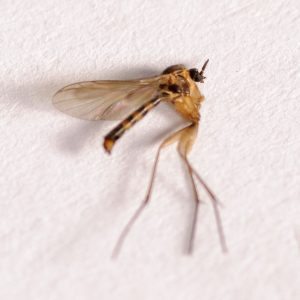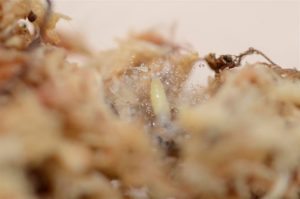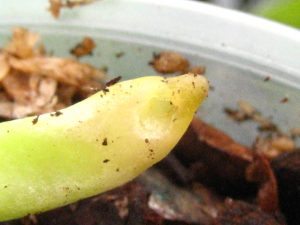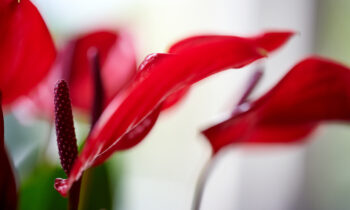The pot worm has been present for many years in the Phalaenopsis cultivation. Fifteen years ago, pot worm control was already a topic of discussion with Phalaenopsis growers. At the time, it was not a major problem. It is significant that back then it was already being recommended to hang a lot of light traps (1 per 200 m²) to control the pot worm mosquitoes, then called Orfelia.
The pot worm has now become a pest. With many Phalaenopsis and other orchid growers, the population of mosquitoes and larvae in the crop (greenhouse and substrate) has become quite substantial in some cases. So substantial, that many plant roots are affected and there is clear growth retardation. Controlling the pot worm is difficult. Chemicals are (almost) not available.
What is the answer?
In order to control the pot worm properly, it is necessary to know which enemy we are dealing with. This requires a lot of attention. And this begins with observing the collection of mosquitoes caught in the light traps.
The researchers at the WUR have been identifying an increasing range of different mosquito species from the traps delivered by IMAC and Anthura, amongst others, after collecting them at several growers.
Origin
The identified mosquitoes seem to be native to South and Central America. The mosquitoes found in the greenhouses which cause damage as larvae have most probably come along with the substrate and/or plant material.
Species
To date, most pot worm species belong to the Keroplatidae family (fungus gnats) such as Lyprauta cambria, Lyprauta chacoensis, Orphelia sp and Proceroplatus trinidadensis. Other mosquitoes are also caught, such as crane flies (Tipulidea) and fungus gnats (Sciaridae). Spot the differences:
Life cycle and way of life
The life cycle of these crane flies is relatively long (in comparison to Sciaridae, for instance). In the greenhouse, however, a large population is quickly built up. As far as we know, the life cycle of pot worm species has never been entirely mapped out. The diagram below indicates the stage of data as is now known:
| Phase | Duration in days |
Remarks |
| Pupa | 4 – 8 | Depending on the temperature |
| Mosquito | 2 – 5 | In this short time, the mosquito mainly lays its eggs |
| Egg | 7 | Very unclear. 7 days on average is considered |
| Larva | 21 – 35 | Depending on conditions such as moisture and temperature |
The eggs and pupae are often deposited in the cultivation substrate. The pupae are usually surrounded by a sort of spider web with moisture droplets. As long as the pot is wet, the larvae live mainly on the outside of the pot (between the substrate and the inner surface of the pot). As soon as the substrate gets dryer, the worm moves up to the pot centre (substrate). The larvae move along very acid slime threads (pH< 3). The larvae almost never move directly along parts of the substrate. After the pupae emerge, the mosquito moves upward through the medium and will start to fly. The mosquitoes move mainly in the evening and at night. The female lays its eggs in a short time. It prefers a moist surrounding for this (moist substrate).
Impingement
The pot worm is mainly found in the growing phase. The first pot worm larvae can often be found in the substrate in the propagation phase, within two to three weeks after potting. Subsequently, the number of mosquitoes and pot worms increases quickly. This also applies to the damage, which is characterised by erosion or chunks out of the root tip.
The plant responds to this by producing new root tips. Usually, by sprouting several root tips slightly above the affected root tips. The growth retardation of the plant relates chiefly to weak absorption of water and nutrients by the root tips in the first weeks of the cultivation and to the extra energy that is needed to produce new root tips. Prev
Prevention and control
Little is known about the pot worm. It is unclear which larvae (mosquito species) can be related to the damage. Observing and counting the mosquitoes in the light traps also shows that sometimes a lot of mosquitoes are counted while no damage is observed in the crop. Solving the pot worm problem focuses on three main spearheads:
- A good understanding and identification of mosquitoes for focused control (watching is knowing);
- Preventing the entry of the pot worm;
- Control of the internal infestation (population).
Knowledge and identification
Anthura and IMAC support the research being carried out on the identification of the mosquitoes. It is still unclear which damage is caused by which mosquito larva. There are still new mosquitoes being found, of which it is unclear whether their larvae cause any damage.
Their behaviour and way of life can vary considerably. It is known, for instance, that pot worms are cannibalistic. They eat their own conspecifics. The question is, however, whether each species is cannibalistic as a larva. In addition, there are indications that the “pot worm” is actually an insect or mould-eater rather than causing direct damage to the root tips. It is unclear, however, whether we are always talking about the same mosquito.
Therefore, it is important to study more thoroughly the appearance and behaviour of the mosquitoes and the pot worms in the pot.
No pot worms in delivered plants and substrates
The pot worm (pupa, egg, larva) can also enter the crop through the plant material and the substrate.
Suppliers of substrates have taken measures to keep tighter control over substrates without any risk of pot worms (pupae).
As regards the delivered plants, in the near future most plants will be cultivated in plugs. As yet it seems that the pot worm is not able to develop in the plug.
Control of internal infestations
No more chemicals of the type that control the older worms properly are allowed. Space treatments for killing the mosquitoes also ensure insufficient control. Young worms are more sensitive to pesticides. Shortly after potting, pesticides can still have some effect.
Crop changes
Changes in the crop and in the growing conditions can help to keep the pot worm under control. There have been confirmed results with regard to the drier cultivation method. Postponing the irrigation session ensures that the substrate continues to dry. There is too little moisture for the pot worm to move. Drier cultivation has some effect, although it is usually temporary. Using the drier cultivation method continuously will be at the expense of plant quality. Dosing a wetting agent with the irrigation water accelerates the drying of the substrate. It is suspected that the wetting agent makes it difficult for the pot worm to make slime trails or that the existing slime trails are dissolved.
Biological agents
Controlling the pot worm with biological agents seems to be very difficult so far. This does not mean that these biological pest controllers do not control the pot worm. Laboratory research showed that nematodes are able to control the pot worm larva properly. Results can also be expected from the application of predatory mites. Not being able to control the pot worm properly in practice often relates to the size of the pot worm population (mosquitoes) and/or the method of application. Let’s give an example. Years ago, Anthurium was unable to control the thrips in the cultivation properly through biological methods. Now, the thrips can be controlled perfectly by using predatory mites and nematodes.
Parasitic wasp
Watching, watching… and surprise. The researchers at the WUR would like to set up a cultivation of pot worms in order to establish more links between mosquitoes, larvae and damage.
Looking closely at the larvae and pupae delivered by Anthura, a pupa was found at the WUR that was parasitized by a parasitic wasp. The pupa concerned was found in the Cambria crop at Anthura. Soon, other parasitized pupae as well as the parasitic wasps were discovered.
Parasitic wasps look for and parasitize pot worms in an aggressive way. In the cold section where the parasitized pupae were found, it turned out that the parasitic wasps multiplied rapidly (within a few weeks) and had parasitized the pot worm population by about 90%. All efforts are being mobilised to learn more about this parasitic wasp and especially the breeding of the parasitic wasp with the expertise of WUR and Koppert, amongst others.
Light traps
The installation of sufficient light traps is proving to be increasingly effective as a means of control of the pot worm. The purpose is to catch the mosquitoes before they start laying eggs. Practice shows that the mosquito population decreases steadily when the blue light traps are installed.
Practical situation:
In a practical situation trap lights were installed: one per 260 m². The number of mosquitoes decreased to a level of 20 mosquitoes per lamp per 24 hours. After some time (months), however, the mosquito population increased to more than 50 mosquitoes per lamp (per 24 hours). This comes down to approximately 200 mosquitoes per 24 hours per 1000 m². It was decided to double the number of lights. Following the installation, fewer than 10 mosquitoes per lamp were counted in a short time (= 80 mosquitoes per 1000 m²).
We are increasingly seeing situations in which the effect of more light traps effectively leads to fewer mosquitoes and as a consequence no damage by the pot worm. It is recommended to install a minimum of one lamp per 150 m². With sufficient light traps per surface area, the distance between the mosquito and the lamp is smaller and it is more likely that a mosquito is caught before it lays eggs. Eradicating the pot worm completely will not be achieved only with light traps. For this reason, a simultaneous control of the pot worm itself is necessary. With a low pot worm population, a biological control can clearly have more effect.
Catch and count:
Most mosquitoes are caught at night. The ratio between day and night is approximately 20:80. A sticky trap is placed in the collecting tray (blue or yellow, it does not matter). The mosquito that comes into contact with the light falls on the glue of the sticky trap and will be stuck. It is possible that mosquitoes that have been in contact with the blue light will continue flying. In addition, the collecting tray can be cleaned more easily by using a (sticky) trap on the bottom. It is recommended to count the number of mosquitoes in the light trap once a week. Clean the collecting tray and put a clean sticky trap on the bottom. Count the number of mosquitoes on this sticky trap 24 hours later. This will give an insight into the increase or decrease of the mosquito population and the possibility to compare with other departments or growers. Control by installing light traps is universal. The flight behaviour of different mosquito species may also vary. But, in principle, the light catches large and small mosquitoes. Sciara are also trapped well.
Type of lamp and installation
It does not seem to matter that much which type of light trap is installed. The size of the lamp, however, does influence the scope of the light. It is likely that with two smaller light traps as many or even more mosquitoes will be caught than with one big light trap. The intention is to install as many lamps as possible per surface area so that the ‘flying’ distance gets smaller.
Abroad there are also Phalaenopsis growers who have installed light traps with fans. The goal is to suck up the mosquito near the lamp (blue light) by means of a powerful fan. The mosquitoes are caught in a bag under the fan (lamp). One single test in the Netherlands seems to indicate that more mosquitoes are caught with these trap lights.
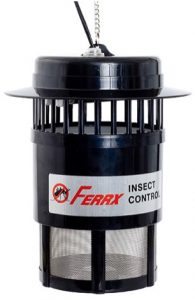
If you are thinking about purchasing these lamps abroad, it is important to keep in mind that the voltage and wattage may be different. An adapter or converter will be needed and this will imply extra risks in the moist greenhouse.
Observe the air humidity in the greenhouse and the irrigation system. Provide the lamps with a cover to prevent water from reaching the lamp and the electrical contacts.
When the lamps are installed, it is advisable to make a connection whereby all the lamps can be switched on and off. The grower can choose to switch the lights on and off via the computer.
As far as we know, the blue light has no harmful effect on the plant growth or shape. When vents and screens are open, it is recommended to switch off the lamps.
Watch and learn!!
By watching regularly, you see and learn a lot. What else can we find beside a parasitic wasp? By thoroughly studying the behaviour of predatory mites, we can apply the existing biological controllers in a more effective way. Together with catching the mosquitoes, biology can be successful in the fight against the pot worm. We can also learn a lot from each other. Together we will certainly achieve more.
This article has been prepared with the cooperation of Bureau IMAC. Anthura and Bureau IMAC cannot be held responsible for any damages, whether direct or indirect, resulting from the use of the cultivation advice given.
Optional (depending on the article)
- The grower is at all times responsible for consulting the label of crop protection products.
- The cultivation information provided is geared towards Dutch growing locations.

